Anal glands are small sacs found on either side of a dog’s anus that play a crucial role in their hygiene and health. So “How to express dog anal glands?”
In this blog, we are going to understand the step-by-step process of expressing anal glands. We will also understand how you can prevent this situation, so without any further ado let’s begin!
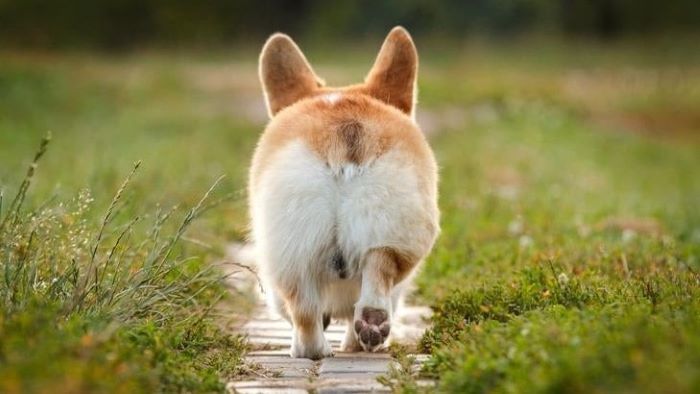
How to Express Dog Anal Glands?
Dogs have little sacs, these are “anal glands” located at 4 and 8 o’clock around the anus. These glands create a foul-smelling brown liquid that helps dogs mark their territory.
When dogs pass stool, the anal glands will naturally express small amounts of this secretion. This is why dogs smell each other’s behinds, to pick up this scent. If these glands fail to correctly express, the pile of fluid can cause infection and other issues.
This can be uncomfortable and painful for dogs. Small dog breeds are at particular risk as their glands tend to be smaller.
Signs of a Dog’s Anal Glands Expression
Let’s see the signs of a dog’s Anal Glands Expression.
- Scooting: Dogs may drag their bottoms on the ground or carpet. This is them trying to relieve discomfort from full anal glands. If you see frequent scooting, it likely means the anal glands need to be expressed[1].
- Licking: Dogs may lick or chew a lot around their bottom or tail. This can happen if the anal glands are irritated. It is their way of trying to make themselves feel better. Look for any redness, swelling, or hair loss here as this could display an anal gland issue.
- Smelly Rear End: If you notice a very stinky smell coming from your dog’s bottom, this can mean the anal glands need emptying. The glands give off a strong odour when full or infected. Any sudden increase in bad smells from that area signals a problem.
- Acting Uncomfortable: Dogs may act differently if their anal glands hurt. Signs can include seeming restless, irritable, or displaying signs of pain. If your dog suddenly changes behaviour and appears uncomfortable, it could indicate their anal glands need relief.
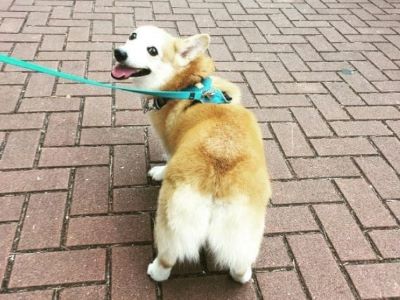
Pay attention to smells and behaviour to spot anal gland issues. Signs like scooting and licking signal discomfort. Catching issues early and having the anal glands emptied can prevent infections and provide ease.
How to Prepare for Anal Glands Expression? Step-By-Step Guide
Collect the essential items to make the process efficient and hygienic and here is your Step-by-Step Guide to Express your dog’s anal glands:
Step- 1: Supplies
When getting ready to express your dog’s anal glands, first create a calm environment in a quiet room where you can gently hold or have someone assist with holding your dog steady.
- Make sure to use a non-slip surface like a towel under your dog for stability.
- Have disposable gloves, tissues/wipes, and a mild pet-safe lubricant within reach. The gloves help keep things hygienic and prevent bacteria from spreading.
- Tissues/wipes will clean up any fluid discharge. The lubricant can minimize discomfort during the process. Go slowly and gently to reduce stress for both you and your dog.
- Having someone else help hold a fidgety dog can make things much easier. The key is being prepared with the proper supplies and setting up a peaceful, soothing area to make anal gland expression as low-stress as possible.
Step- 2: Wash Your Hands and Wear Gloves
Prioritize cleanliness to prevent the transfer of bacteria and further infection. Thoroughly wash your hands with soap and water. Put on disposable gloves to protect yourself and maintain hygiene.
Set your dog in a comfortable position for the expression process. Have your dog stand with their back to you or lie down on their side. Provide gentle reassurance and speak calmly to keep them comfortable.
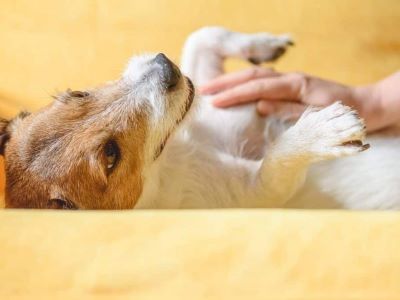
Step- 3: External Expression Technique
To express the anal glands, you first need to locate them. The glands are small sacs situated on either side of the dog’s anus, around the 4 o’clock and 8 o’clock positions[2].
Gently apply pressure with your thumb and finger, pushing inward from the outside area of each gland. Slowly increase pressure to allow the fluid to be released while ensuring not to squeeze too hard to cause pain. When you see the glands are draining, you can stop applying pressure.
Use a tissue or wipe to carefully clean up any discharged liquid or material that leaks out. Remember to release pressure and let the glands fully express before wiping the area around the anus clean.
Go slowly and be very gentle, stopping if the dog shows any sign of distress. The key steps are locating each gland, gently squeezing to express fluid, and then cleaning up afterwards.
Step- 4: Internal Expression Technique
Internally expressing anal glands requires inserting a finger into the dog’s anus, so it should only be attempted under veterinary guidance. First speak to your vet, as they can recommend if internal expression is necessary based on your dog’s condition.
They can provide specific instructions to minimize discomfort. If advised to proceed, put lubricant on a gloved hand. This allows smooth, gentle insertion into the anus. Carefully insert your lubricated finger, then softly apply pressure on the anal glands to release fluid.
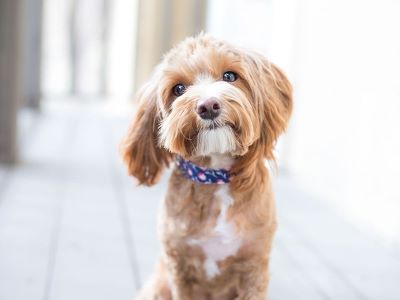
Remain attentive to your dog’s comfort, stop immediately if they show any signs of distress. Internal expression requires caution and care to avoid harm.
Have an expert vet walk you through the proper technique beforehand if the external method is insufficient. The key is using lots of lube, going slowly, and stopping at the first sign of pain or resistance from the dog.
Step- 5: Aftercare
Dispose of used gloves and tissues hygienically. Wash your hands thoroughly with soap and water. Observe your dog for any signs of discomfort, and provide reassurance and treats as needed.
If you are uncomfortable with this process then consult with your vet, remember your dog’s comfort is important for this.
Step- 6: Aftercare and Preventive Measures
Cleanliness is very important after expressing anal glands to prevent infection and discomfort. Gently wipe the area around the anus using pet-safe wipes or a damp, soft cloth.
Correctly dispose of any used tissues or wipes. Keep an eye on your dog to ensure they are calm and comfortable.
Watch for signs of continued problems like excessive licking, swelling, or changes in behavior that could signify infection. Contact your vet if you notice redness, discharge, or changes in energy level or appetite after anal gland expression.
Discuss diet adjustments with your vet too, as added fiber can encourage healthy bowel movements to support anal gland function. Also be diligent about regular veterinary checkups to stay on top of your dog’s health and get guidance about ideal anal gland care.
When to Seek Veterinary Assistance for Dog Anal Gland Issues?
If anal gland problems continue despite expressing them at home, you need to take your dog to the vet. Constant issues signal something more serious is going on.
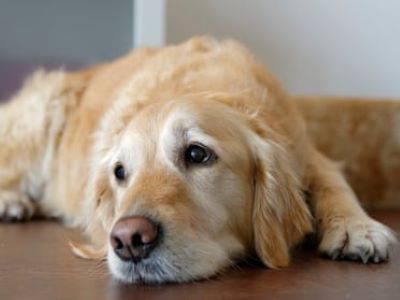
Make an appointment with your vet so they can examine your dog, run tests, and determine the underlying cause. Anal gland infections or bleeding need quick vet’s attention. Changes in behavior can also show anal gland discomfort in dogs.
Irritability, aggression, reluctance to sit or lie down, or avoidance behaviors should be checked by a vet. They can assess if the behavioral shifts stem from painful anal gland impaction or infections.
FAQs
Can I Express My Dog’s Glands Myself?
DON’T. Expressing your dog’s anal glands means manually squeezing them to remove the fluid. Some groomers and vets do this routinely, and they may tell you to do it yourself too. Please don’t do it and don’t let your groomer or vet do it either!
How to Express Dog Anal Glands?
In one hand, hold a paper towel underneath and behind your dog to prevent any fluid from their anal glands from getting onto you. Then, squeeze the anal glands together with your thumb and index finger to release the fluid. Step. As you squeeze, a smelly, brown fluid will be released from the anal glands.
Does It Hurt a Dog to Express Glands?
It is much easier to express your dog’s anal glands if you have someone to help you gently restrain your dog as the expression is often uncomfortable (though not painful unless there is an infection or obstruction). Your dog may feel some pressure while you are pushing on the glands.
How Do You Tell if a Dog’s Glands Are Full?
Dogs that have full anal glands may display signs of discomfort or pain. This discomfort can manifest as whining, whimpering, restlessness, or pacing. Additionally, your dog might frequently turn around to look at or bite at their hindquarters, as if trying to relieve the discomfort.
Can Dogs Express Their Glands by Licking?
Dogs lick at the area to relieve discomfort and “clean” areas with their saliva. If they’re doing it more than usual, It might cause a larger issue. Dogs can typically express their anal glands themselves, but if they can’t, it can mean that the smelly fluid inside is built up to the point of discomfort.
Conclusion
In conclusion “How to express dog anal glands?” Expressing full anal glands can provide relief for dogs and prevent impaction.
We saw a step-by-step guide to express dog’s anal glands. However, this process must be done gently and hygienically to avoid pain or discomfort.
Consult with your vet to know what your dog needs, they will guide you for all the necessary process and its implications. Remember it is up to you to keep them healthy cause a healthy dog is a happy dog!
Reference:



